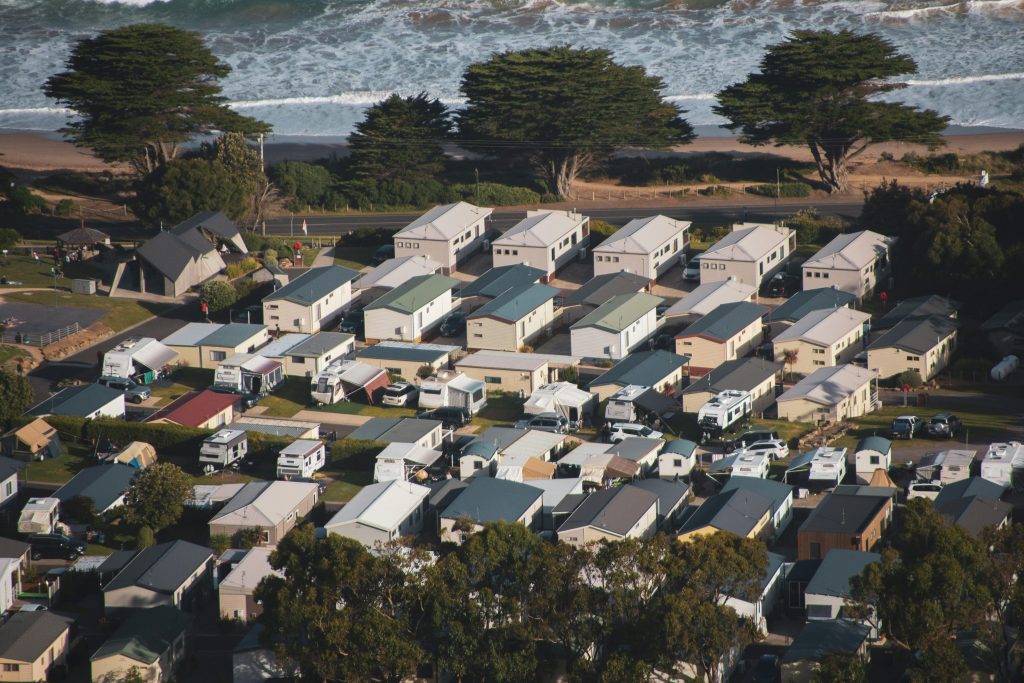Houses in Apollo Bay, Victoria. Photo by Nao Takabayashi
By Ruth Puddefoot.
Mediterranean countries, such as Greece and Turkey, boast picturesque white houses famous for their ability to reflect sunlight and minimise solar heat absorption, ensuring comfort for their residents amidst the hot summer months.
While Australia is renowned for its high temperatures and warm climates, new builds around the Melbourne and Sydney regions do not reflect the traditional building architectures present in Mediterranean countries. Instead, housing estates in Sydney and Melbourne’s hottest suburbs are characterized by treeless streets, dark-coloured roofs, and black roads.
Dark roofs may look aesthetically pleasing; however, their environmental implications are not so attractive. In contrast to lighter alternatives, dark-coloured roofs absorb and retain heat, leading to increased energy consumption.
Researchers from UNSW and Western Sydney have recently suggested that darker roofs could boost energy bills by a colossal 38%, while a lighter-coloured roof could save homeowners around $700.
A dark roof is not only impactful on homeowners’ bills but also exacerbates what is known as the urban heat island effect. National Geographic has defined heat islands as a ‘metropolitan area that’s a lot warmer than the rural areas surrounding it.’ Further research on heat islands has suggested that in large cities, the temperature can be 1°C to 3°C hotter than in rural areas.
Penrith exemplifies this notion, reaching peaks of over 45°C in summer months. In 2020, the suburb was recorded as the hottest place on earth, documenting a sweltering 48.9°C. Such extreme heat exposes residents to dehydration risks and subjects trees to water-stressed conditions, interfering with their health and, thus, cooling potential.
Recently, a reliance on air conditioning units has replaced traditionally used cooling devices. Due to this transition coupled with increases in temperatures, homeowners in these areas are consuming more electricity and facing higher bills. Meanwhile, air conditioning units continue to recycle heat from the inside back outside, adding to the heat island effect.
As a result, heatwaves are predicted to increase by 5 to 4.5 events per year by 2070. Heatwaves, while uncomfortable, are more disturbingly known as ‘silent killers’, and are responsible for 1,100 deaths around Australia each year. Therefore, the demand to mitigate potential heat increases is on the rise.
Keeping Australian Residents Cool
While Australia is known for its heat, the houses don’t have to be. Research has found that during summer, light-coloured roofs are estimated to reduce indoor air temperature by up to 12°C. Subsequently, in large proportion, lighter roofs can even reduce overall temperatures in entire neighbourhoods.
Painting dark roads lighter or using retroreflective coatings on them is also another measure proposed to have a marginal impact on cities’ temperatures, even reducing temperatures by 13°C.
Light roofs and reflective roads are not the only solutions to cooling down cities, however. Increasing green infrastructure and planting more trees can help shade houses from the heat, whilst also being proven to reduce the heat island effect.
Photo of Grey Appliance, and Air Conditioner by Carlos Lindner (@realbench).
Demands for Government Action are Heating Up
In 2020, plans by the New South Wales government to ban dark roofs were set in motion. However, by 2022, these plans were abandoned after facing fierce criticism by property developers.
Despite the axed plans, in October of last year, the NSW Building Sustainability Index (BASIX) unveiled new initiatives aimed at implementing stricter requirements for new constructions, including tougher regulations on dark-coloured roofs.
While a step in the right direction, experts continue to advocate for a complete ban on dark roofs, and with good reason. As temperatures and heat waves worsen annually, it is more vital than ever to reduce cities’ temperatures. Failure to act will result in continually high energy bills, houses reminiscent of greenhouses, and dangerous climatic conditions.
Plants, seeds & more delivered to your door!
www.nativeshop.com.au
Advertisement




